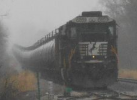Were Cab Forwards also used on passenger trains over Donner Pass or did SP put GS4's up front?
That's a big yes! Cab Forwards were standard power for such trains as the Overland Limited (Trains # 26 and 27) and the Gold Coast Commonly referred to as the "Cold Roast" between Roseville and Sparks. If the consists were unusually heavy, two ACs were double headed as SP operating rules prohibited pushers on Passenger trains.
GS4's were rarely used over Donner Pass probably because of their 80 inch drivers would tend to be somewhat slippery in addition to being hard on the rails due to the many curves and curvature, , however GS6s were occasionally used. Mountain (4-8-2s) and Consolidations (2-8-0s) saw frequent duty on the hill.





